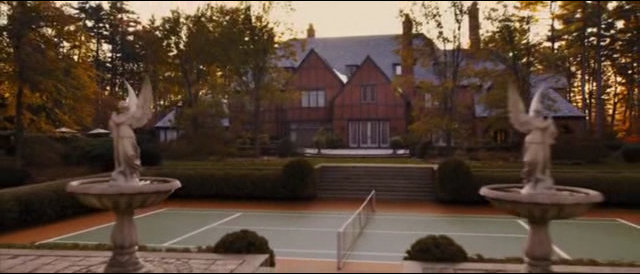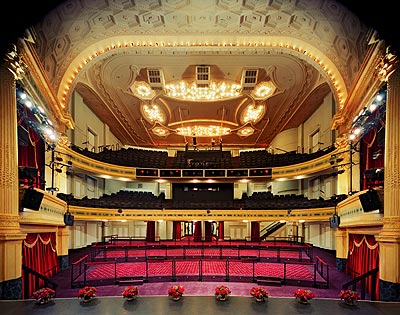
The history of money is strewn with hoaxes and the anti-heroes who rise and fall by them. Martin Scorsese’s The Wolf of Wall Street sends up an especially bracing example based on the bestselling memoir of Jordan Belfort, played with Oscar-nominated flair by Leonardo DiCaprio.
To convey the debauched life and times of this high-rolling shyster who conned unsuspecting investors into forking over $100 million plus in the late '80s and '90s, the filmtakes us deep into the lairs of Belfort’s wolfish exploits. Three hours and 150 locations later, we too have prowled his country mansion, Long Island beach house, flinty Manhattan penthouse and offices ranging from strip-mall scuzzy to faux-brokerage house posh. The spectacle alone dramatizes this giddy, drug-soaked tale of excess that has netted Academy Award nominations for Best Picture, Actor in a Supporting Role, Directing, Writing and Adapted Screenplay (not counting Actor in a Leading Role, mentioned above).
Production designer Bob Shaw teamed with Scorsese to recreate the look of the greed-is-good era. Shaw is best known for his work on such hit television series as "The Sopranos," "Mad Men" and "Boardwalk Empire" and on movies including Too Big to Fail and The Ice Man.
I got Shaw on the line to deconstruct his sets for Scorsese's latest first-person narrative, which he considers "a third panel in a tryptich" including Goodfellas and Casino. But for Shaw this last tier co-starring Jonah Hill, Matthew McConaughey, Margot Robbie and Jean DuJardin "outdoes the other two by the conspicuousness of the consumption." As a lead into our animated chat, he quipped, "Jordan is more a kid in a candy store. And he doesn't stop eating."
Q: How does the set tell the Jordan Belfort story?
BS: It tells it in two parallel tracks. In Jordan's personal life he goes from living in this little, tiny apartment in Queens to this estate and a lavish penthouse in New York City. In his professional life he goes from working for other people and having an office in a body shop to having a repurposed 1980s office and then arriving at the point where he's trying to look like he runs a distinguished brokerage firm. There's a very clear progression of the character's life as reflected in these environments.
Q: Did you watch such films as Wall Street, American Psycho, Boiler Room -- which was also inspired by the Belfort case -- and Glengarry Glen Ross, and if so, what did they give you?
SB: I looked at Glengarry Glen Ross -- which I'd worked on as an assistant art director -- because it was from this period. Seeing it now I thought it looked very studio-like, not realistic. I also looked at Boiler Room, which was a different budget level and of film and didn't have the resources to portray the opulence and conspicuous consumption. So I watched it for the energy, yes, but it wasn't a visual touchstone. On most films I say I'm looking for the Rosetta Stone, but I didn't feel like I was looking for that on this film. I went into it with an intuitive feeling for the '80s, so I felt that I had a handle it.
Q: So you were no stranger to turquoise and orange?
BS: We start in 1987 and go through the mid-'90s, and the '80s look persists through the early '90s. There's no escaping some of the color palettes from that period, like the peach and aqua or peach and teal. Another big color combination was pink and grey. And it's almost impossible to escape mauve. The color palette is essential for putting you in that time period. You get a lot of postmodern knock-offs of pyramids and spheres done up in a dash of Southwest colors. It was the Calvin Klein '80s -- and they sort of meet.
Q: Was there a recurring visual theme that riffed on the narrative?
BS: One of the things that very few people would notice is that there was a nautical theme. "Oh, there's a boat photograph here; there's a model of a boat there; there are boat sculptures, boat paintings!" That was a tie-in to the whole boat-sinking disaster of the show. There's even a table that's a ship wheel. It's implying that the sinking of the boat is a turning point in the film and in Jordan's life. He indicated that it took going out against the captain's orders in a storm and having this boat sink and literally break in half and be rescued by the Italian Navy to have him say, "Maybe I've gone too far."
Q: In Zhang Yimou's epic drama Curse of the Golden Flower the Imperial Palace is stunning when we first see it, but all the sumptuousness appears rotten after its inhabitants reveal how monstrous they are. Did you underscore Wolf's decor with any moral commentary?
SB: It's not something that I sought to bring to the look of the show. There are times when you don't need for the decor to make the statement because the people are already making it. I once did a pilot for HBO with a well known comedian who said, "The furniture doesn't need to be funny. The people are funny. The situation is funny. The sofa doesn't need to be funny."
Q: How did Belfort's memoir The Wolf of Wall Street inform your work?
BS: We had one script where there were elements selectively taken from that memoir and from his other one, Catching the Wolf of Wall Street. There was such a wealth of information and such a reluctance to let any of it go, but it couldn't all be in the movie. Leo would say to Marty, "You know, I was always sorry that we couldn't take certain scenes." But with any project you have to decide when to accurately portray reality and when to do something that's slightly different to convey, in this case, conspicuous consumption.
Q: What's an example?
BS: We scouted Jordan's original house in Old Brookvile on Long Island, but it was not as posh as we thought and the floor plan would not allow for the camera movement. It had a very, very large living room, but you could only enter it from one end of the room. What works for us is a room that flows from one end to the other. Plus the children's rooms were too small. So we chose a house that was quite a bit larger.
Q: How does the aesthetic of the featured house reflect the characters?
BS: It was quite an opulent home and very large, but was done in pretty excellent taste. We felt it was appropriate that the family look like landed gentry. This is an English manor house in the tradition of Henry the III's Hampton Court, all brick and Tudor and with many, many chimneys. It reflects more of a Ralph Lauren classic aesthetic, which is inherently less satirical. Keying off the characters I thought it was somewhat more of a statement to go for this look. It wasn't a statement about crassness.
I had worked on "The Sopranos" for many years, so some people came into the project thinking it would be a matter of lots of money and questionable taste. Jordan's actual wife, Nadine -- Naomi in the film -- had a high-end and pretty sophisticated sense of decoration. In both the book and the movie, Jordan called her "the Duchess of Bay Ridge," or "the Duchess," which was a little bit of a verbal cue for this English manor house. Her aunt is English and she makes this comment about having family in England even though she says she's a mutt.
Q: How did you factor in Belfort's taste?
BS: Obviously, there was a lot of rock star behavior on the part of Jordan and his associates, but they did have the most high-end cars. The yacht that breaks in two and collapses both in the film and in reality originally belonged to Coco Chanel. It was very interesting that Jordan bought a boat that was owned by Coco Chanel rather than something more contemporary.
Q: What did you learn from speaking with Belfort?
BS: He has complete recall of everything. He'd say, "Oh yes, that took place at X," and he'd give the exact address. He knew exactly when he bought a certain car or suit. In my phone conversation with him, he talked about how upscale the ultimate Stratton Oakmont office was, but at the end of the day it was still just an office. And from what I can see, what we had was a little more handsome than what was really in his office. We didn't try to go further with it. We thought it was all about the traders keeping their eyes on the prize.
Q: Particularly at Stratton Oakmont?
BS: Not necessarily, but I heard amazing stories about the pressure of those jobs where the employees are being watched every second. When we were scouting for space, the realtor said he'd had many complaints about the traders. There's a lot of burnout and there's a certain fratboy element. The cleaning staff was finding cups of urine around the desks because the traders were so compelled not to leave their posts that they would rather leave a cup of urine than go down the hall to the bathroom. This realtor was happy to see them go because it's such a high-performance, young person's game.
Q: How did you work with cinematographer Rodrigo Prieto to create a different look for the various Stratton Oakmont offices?
BS: When we were shooting Stratton Oakmont 2, our schedule wasn't allowing us to capture it in real time. We were filming in Manhattan and the location didn't have the appropriate views out the window. So we kept the set more interior. The material for that time was glass block.
In the first Stratton Oakmont, the one that was in a former auto shop, Rodrigo wanted to combine incandesent and florescent light. We were going to have more florescent light in the more conventional offices. The viewer should instantly realize a new setting: this office has wooden desks; this one has metal desks; this one has formica desks. That's as much for visual relief as for a very quick, clear read: "Oh, we're in a different place."
Q: Is this also why the beach house has a contemporary design?
SB: Yes. It was a very '70's- or '80s-looking house, which was more for visual relief than anything. We were already making the landed-gentry statement with the estate. In reality the beach house was very shabby chic, which was very big at the time -- the overstuffed furniture and the bleached wood. But it's important to vary and not always hit the same note.
Q: When Gangs of New York came out, Scorsese talked about the vogue of women's dress sleeves in early 1862 as opposed to what became trendy later that year. How did his granular command of period detail influence your work?
BS: Marty is certainly one of the most intellectually curious people you will ever meet. Everyone knows him as the great sudent of film history, but what they don't realize is that he's a student of history, period. People who worked on The Age of Innocence talked about his request for a certain kind of scissors that was used to clip the end of a cigar. For Marty, these details tell a story.
Jordan took his second wife on their first date to the Sign of the Dove, which was a famous New York restaurant at that time. The walls were brick and there were classical urns and elegant flower arrangements. Marty wanted us to evoke the feeling of the real place, which said something to him about where it stood in the hierarchy of New York establishments. It means one thing if Jordan takes her to the Sign of the Dove as opposed to Tavern on the Green. Whenever possible, though, Marty would start with the real thing. Then we would decide if we were going to embellish or alter something for our purposes.
Q: How did Leonardo DiCaprio weigh in on the production design?
BS: He was very on top of things. At one point we were discussing what sort of furniture would go in the scene where Naomi says, "...mommy's never going to wear underwear anymore." As we were thinking about which kind of furniture she could lean against, I was on the floor splay-legged and Leo started crawling toward me. I was very, very embarrased and he was enjoying how embarrassed I was!
Q: Is it true that Leo was the reason the owners of the palatial home said yes to the shoot?
SB: I've told people that the owners had teenage daughters who said, "You're going to ruin my life if you don't let Leo DiCaprio into my home!" [The owners] did say that their daughters basically went, "Come on, do this!" So there was definitely pressure from the kids. The owners were just amazing people. We were extremely lucky to get such a wonderful family and not just a wonderful home. As we were prepping, the lady of the house was baking cookies. She continued to make little treats for Marty. At one point she asked, "Are you going to be here on Thursday? -- because I'm making rice balls." They went to the movie premiere. I think they were a little surprised to see how racy and "adult" the film was. But they were tremendously good sports.
































